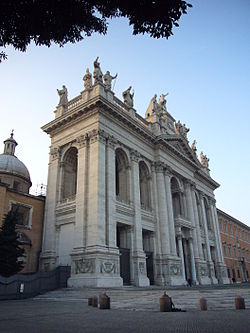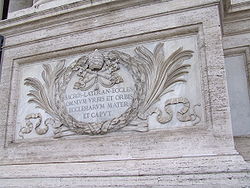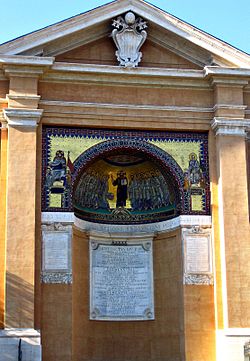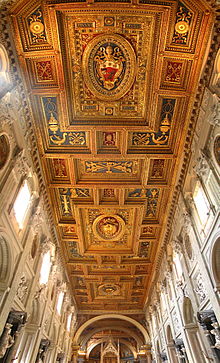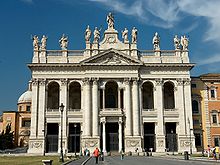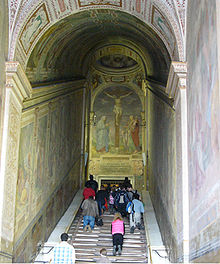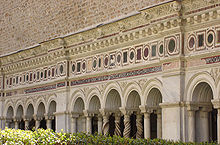- Basilica of St. John Lateran
-
Papal Archbasilica of St. John Lateran
Archibasilica Sanctissimi Salvatoris et Sanctorum Iohannes Baptistae et Evangelistae in Laterano
Omnium urbis et orbis ecclesiarum mater et caput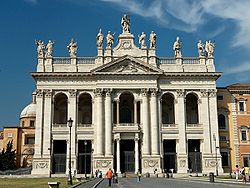
Facade of the Basilica of St. John Lateran
Basic information Location  Rome
RomeGeographic coordinates 41°53′9.26″N 12°30′22.16″E / 41.8859056°N 12.5061556°ECoordinates: 41°53′9.26″N 12°30′22.16″E / 41.8859056°N 12.5061556°E Affiliation Roman Catholic Year consecrated 324 Ecclesiastical or organizational status Major basilica Leadership Agostino Vallini Website Official Website Architectural description Architect(s) Alessandro Galilei Architectural type Cathedral Architectural style Baroque Direction of façade ENE Groundbreaking 4th century Specifications Length 140 metres (460 ft) Width 140 metres (460 ft) Width (nave) 65 metres (213 ft) The late Baroque façade of the Basilica of St. John Lateran was completed by Alessandro Galilei in 1735 after winning a competition for the design.
The Papal Archbasilica of St. John Lateran (Italian: Arcibasilica Papale di San Giovanni in Laterano), commonly known as St. John Lateran's Archbasilica and St. John Lateran's Basilica, is the cathedral of the Diocese of Rome and the official ecclesiastical seat of the Bishop of Rome, who is the Pope. The official name, in Latin, is Archibasilica Sanctissimi Salvatoris et Sanctorum Iohannes Baptista et Evangelista in Laterano, which translates in English as Archbasilica of the Most Holy Saviour and Ss. John the Baptist and the Evangelist at the Lateran, and in Italian as Arcibasilica del Santissimo Salvatore e Santi Giovanni Battista ed Evangelista in Laterano.[1]
It is the oldest and ranks first among the four Papal Basilicas or major basilicas of Rome (having the cathedra of the Bishop of Rome).[2] It claims the title of ecumenical mother church among Catholics. The current archpriest of St. John Lateran is Agostino Vallini, Cardinal Vicar General for the Diocese of Rome.[1] The President of the French Republic, currently Nicolas Sarkozy, is ex officio the "first and only honorary canon" of the basilica, a title inherited from the Kings of France, who have held it since Henry IV of France.
An inscription on the façade, Christo Salvatori, indicates the church's dedication to "Christ the Saviour", for the cathedrals of all patriarchs are dedicated to Christ himself. As the cathedral of the Bishop of Rome, it ranks above all other churches in the Catholic Church, including St. Peter's Basilica in the Vatican City. For that reason, unlike all other Roman Basilicas, it holds the title of Archbasilica. The cathedral itself is located outside of the Vatican boundaries, within the city of Rome. However it has been granted a special extraterritorial status as one of the properties of the Holy See. This is also the case with several other buildings, after the solving of the Roman Question with the Lateran Treaty. The Lateran Basilica is adjacent to the Lateran Palace.
Contents
Lateran Palace
The basilica itself stands over the remains of the Castra Nova equitum singularium, the 'new fort' of the imperial cavalry bodyguard. The fort had been established by Septimius Severus in AD 193, but following the victory over Maxentius (whom the Equites singulares augusti had fought for) at the Battle of the Milvian Bridge by Constantine I the guard were abolished and the fort demolished. Substantial remains of the fort lie directly beneath the basilica nave. The rest of the Basilica site was occupied during the early Roman Empire by the palace of the gens Laterani. The Laterani served as administrators for several emperors; Sextius Lateranus was the first plebeian to attain the rank of consul. One of the Laterani, Consul-designate Plautius Lateranus, became famous for being accused by Nero of conspiracy against the emperor. The accusation resulted in the confiscation and redistribution of his properties.
 The square in front of the Lateran Palace has an obelisk commissioned by Pharaoh Thuthmose III and completed by his grandson Thutmose IV in Karnak, and placed in the Circus Maximus before being re-erected in its current place.
The square in front of the Lateran Palace has an obelisk commissioned by Pharaoh Thuthmose III and completed by his grandson Thutmose IV in Karnak, and placed in the Circus Maximus before being re-erected in its current place.
The Lateran Palace fell into the hands of the emperor when Constantine I married his second wife Fausta, sister of Maxentius. Known by that time as the "Domus Faustae" or "House of Fausta," the Lateran Palace was eventually given to the Bishop of Rome by Constantine. The actual date of the gift is unknown but scholars believe it had to have been during the pontificate of Pope Miltiades, in time to host a synod of bishops in 313 that was convened to challenge the Donatist schism, declaring Donatism as heresy. The palace basilica was converted and extended, becoming the residence of Pope St. Silvester I [2], eventually becoming the cathedral of Rome, the seat of the popes as bishops of Rome.
The Middle Ages
The official dedication of the Basilica and the adjacent Lateran Palace was presided over by Pope Sylvester I in 324, declaring both to be Domus Dei or "House of God." In its interior, the Papal Throne was placed, making it the Cathedral of the Bishop of Rome. In reflection of the basilica's claim to primacy in the world as "mother church", the words Sacrosancta Lateranensis ecclesia omnium urbis et orbis ecclesiarum mater et caput (meaning "Most Holy Lateran Church, of all the churches in the city and the world, the mother and head") are incised in the front wall between the main entrance doors.
The Lateran Palace and basilica have been rededicated twice. Pope Sergius III dedicated them to Saint John the Baptist in the 10th century in honor of the newly consecrated baptistry of the Basilica. Pope Lucius II dedicated the Lateran Palace and basilica to Saint John the Evangelist in the 12th century. However, St. John Baptist and St. John the Evangelist are regarded as co-patrons of the Cathedral, the chief patron being Christ the Saviour himself, as the inscription in the entrance of the Basilica indicates, and as is tradition in the patriarchal cathedrals. Thus, the Basilica remains dedicated to the Saviour, and its titular feast is the Transfiguration. That is why sometimes the Basilica will be referred to by the full title of Archbasilica of the Most Holy Saviour and of Sts. John Baptist and John Evangelist in the Lateran.[3] The church became the most important shrine in honor of the two saints, not often jointly venerated (but see Peruzzi Chapel, Santa Croce, Florence). In later years, a Benedictine monastery was established at the Lateran Palace, devoted to serving the basilica as a devotional to the two saints.
Every pope from Miltiades occupied the Lateran Palace until the reign of the French Pope Clement V, who in 1309 decided to transfer the official seat of the Catholic Church to Avignon, a papal fief that was an enclave within France. The Lateran Palace has also been the site of five Ecumenical councils. See Lateran councils.
Lateran fires
During the Avignon papacy, the Lateran Palace and the basilica began to decline. Two destructive fires ravaged the Lateran Palace and the basilica, in 1307 and again in 1361. In both cases, the Avignon papacy sent money to their bishops in Rome to cover the costs of reconstruction and maintenance. Despite the action, the Lateran Palace and the basilica lost their former splendor.
When the Avignon papacy formally ended and the Pope again resided in Rome, the Lateran Palace and the basilica were deemed inadequate considering the accumulated damage. The popes took up residency at the Basilica di Santa Maria in Trastevere and later at the Basilica di Santa Maria Maggiore. Eventually, the Palace of the Vatican was built (adjacent to the Basilica of St. Peter, that already existed at the Vatican since the time of Constantine), and the papacy moved in; the papacy remains there today.
Reconstruction
There were several attempts at reconstruction of the basilica before Pope Sixtus V's definitive project. Sixtus hired his favorite architect Domenico Fontana to oversee much of the project. The original Lateran Palace was torn down and replaced with a new building. On the square in front of the Lateran Palace is the largest standing obelisk in the world, known as the Lateran Obelisk (weight estimated at 455 tons). Its manufacture was started by Thutmose III and it was erected by Thutmose IV before the great Karnak temple of Thebes, Egypt.[3] Intended by Constantine I to be shipped to Constantinople, the very pre-occupied Constantius II had it shipped instead to Rome, where it was re-erected in the Circus Maximus in 357. At some time it broke[3] and was buried under the Circus. In the 16th century it was located and dug up, and Sixtus V had it re-erected on a new pedestal on August 3, 1588 on its present site.[3][4][5]
Further renovation on the interior of the basilica ensued under the direction of Francesco Borromini, commissioned by Pope Innocent X. The twelve niches created by his architecture came to be filled by 1718 with statues of the apostles, using the most prominent Roman Rococo sculptors.
The vision of Pope Clement XII for reconstruction was an ambitious one: he launched a competition to design a new façade. Over 23 architects, mostly working in the current Baroque idiom competed. The putatively impartial jury was chaired by Sebastiano Conca, president of the Roman Academy of Saint Luke. The winner of the competition was Alessandro Galilei. The façade as it appears today was completed in 1735. Galilei's façade however removed all vestiges of traditional ancient basilica architecture, and imparted a neo-classical facade.
 The Papal cathedra, which makes this basilica the cathedral of Rome, is located in the apse. The decorations are in cosmatesque style.
The Papal cathedra, which makes this basilica the cathedral of Rome, is located in the apse. The decorations are in cosmatesque style.
Architectural history
An apse lined with mosaics and open to the air still preserves the memory of one of the most famous halls of the ancient palace, the "Triclinium" of Pope Leo III, which was the state banqueting hall. The existing structure (illustration, below left) is not ancient, but it is possible that some portions of the original mosaics have been preserved in the three-part mosaic of its niche: in the centre Christ gives their mission to the Apostles, on the left he gives the keys to St. Sylvester and the Labarum to Constantine, while on the right St. Peter gives the papal stole to Leo III and the standard to Charlemagne.
Some few remains of the original buildings may still be traced in the city walls outside the Gate of St. John, and a large wall decorated with paintings was uncovered in the 18th century within the basilica itself, behind the Lancellotti Chapel. A few traces of older buildings also came to light during the excavations made in 1880, when the work of extending the apse was in progress, but nothing was published of real value or importance.
A great many donations from the popes and other benefactors to the basilica are recorded in the Liber Pontificalis, and its splendour at an early period was such that it became known as the "Basilica Aurea", or Golden Basilica. This splendour drew upon it the attack of the Vandals, who stripped it of all its treasures. Pope Leo I restored it around 460, and it was again restored by Pope Hadrian, but in 897 it was almost totally destroyed by an earthquake— ab altari usque ad portas cecidit "it collapsed from the altar to the doors"— damage so extensive that it was difficult to trace the lines of the old building, but these were in the main respected and the new building was of the same dimensions as the old. This second church lasted for four hundred years and then burned in 1308. It was rebuilt by Pope Clement V and Pope John XXII, only to be burned down once more in 1360, but again rebuilt by Pope Urban V.
Through these various vicissitudes the basilica retained its ancient form, being divided by rows of columns into aisles, and having in front a peristyle surrounded by colonnades with a fountain in the middle, the conventional Late Antique format that was also followed by the old St Peter's. The façade had three windows, and was embellished with a mosaic representing Christ, the Saviour of the World. The porticoes were frescoed, probably not earlier than the 12th century, commemorating the Roman fleet under Vespasian, the taking of Jerusalem, the Baptism of the Emperor Constantine and his "Donation" of the Papal States to the Church. Inside the basilica the columns no doubt ran, as in all other basilicas of the same date, the whole length of the church from east to west, but at one of the rebuildings, probably that which was carried out by Clement V, the feature of a transverse nave was introduced, imitated no doubt from the one which had been added, long before this, at Basilica of Saint Paul Outside the Walls. Probably at this time the church was enlarged.
Some portions of the older buildings still survive. Among them the pavement of medieval Cosmatesque work, and the statues of St. Peter and Saint Paul, now in the cloisters. The graceful baldacchino over the high altar, which looks so utterly out of place in its present surroundings, dates from 1369. The stercoraria, or throne of red marble on which the popes sat, is now in the Vatican Museums. It owes its unsavoury name to the anthem sung at the papal enthronement, "De stercore erigens pauperem" ("lifting up the poor out of the dunghill", from Psalm 112).
From the 5th century there were seven oratories surrounding the basilica. These before long were incorporated in the church. The devotion of visiting these oratories, which held its ground all through the medieval period, gave rise to the similar devotion of the seven altars, still common in many churches of Rome and elsewhere.
Of the façade by Alessandro Galilei (1735), the cliché assessment has ever been that it is the façade of a palace, not of a church. Galilei's front, which is a screen across the older front creating a narthex or vestibule, does express the nave and double aisles of the basilica, which required a central bay wider than the rest of the sequence; Galilei provided it, without abandoning the range of identical arch-headed openings, by extending the central window by flanking columns that support the arch, in the familiar Serlian motif. By bringing the central bay forward very slightly, and capping it with a pediment that breaks into the roof balustrade, Galilei provides an entrance doorway on a more-than-colossal scale, framed in the paired colossal Corinthian pilasters that tie together the façade in the manner introduced at Michelangelo's palace on the Campidoglio.
Holy Steps
The Scala Sancta (Holy Stairs), wooden steps that encase white marble steps, are, according to Roman Catholic tradition, the staircase leading once to the praetorium of Pilate at Jerusalem, hence sanctified by the footsteps of Jesus Christ during his Passion. The marble stairs are visible through openings in the wooden risers. Their translation from Jerusalem to the complex of palaces that became the ancient seat of popes in the 4th century is credited to Saint Helena, mother of the Emperor Constantine I.
In 1589, Pope Sixtus V relocated the steps to their present location in front of the ancient palatine chapel (the Sancta Sanctorum). Ferraù Fenzoni completed some of the frescoes on the walls.
Lateran cloister
Between the basilica and the city wall there was in former times the great monastery, in which dwelt the community of monks whose duty it was to provide the services in the basilica. The only part of it which still survives is the 13th-century cloister, surrounded by graceful twisted columns of inlaid marble. They are of a style intermediate between the Romanesque proper and the Gothic, and are the work of Vassellectus and the Cosmati. This beautiful cloister dates to the early 13th century.
Lateran baptistry
The octagonal Lateran Baptistry stands somewhat apart from the basilica. It was founded by Pope Sixtus III, perhaps on an earlier structure, for a legend grew up that Constantine I had been baptized there and enriched the structure. (He was actually baptised in the East, by an Arian bishop.) This baptistry was for many generations the only baptistry in Rome, and its octagonal structure, centered upon the large basin for full immersions provided a model for others throughout Italy, and even an iconic motif of illuminated manuscripts, "The fountain of Life".
Papal tombs
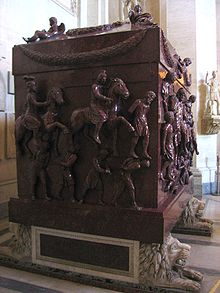 The Helena sarcophagus, reused by Anastasius IV, the only tomb to survive the Lateran fires (currently in the Vatican Museums)
The Helena sarcophagus, reused by Anastasius IV, the only tomb to survive the Lateran fires (currently in the Vatican Museums) Main article: List of extant papal tombs
Main article: List of extant papal tombsThere are six extant papal tombs inside the basilica: Alexander III (right aisles), Sergius IV (right aisles), Clement XII Corsini (left aisle), Martin V (in front of the confessio); Innocent III (right transept); and Leo XIII (left transept), by G. Tadolini (1907). The latter was the last pope not to be entombed in St. Peter's Basilica.
A dozen additional papal tombs were constructed in the basilica starting in the 10th century, but were destroyed during two fires that ravaged the basilica in 1308 and 1361. The remains of these charred tombs were gathered and reburied in a polyandrum. The popes of the destroyed tombs were: Pope John X (914 - 928), Pope Agapetus II (946 - 955), Pope John XII (955- 964), Pope Paschal II (1099–1118), Pope Callixtus II (1119–1124), Pope Honorius II (1124–1130), Pope Celestine II (1143–1144), Pope Lucius II (1144–1145), Pope Anastasius IV (1153–1154), Pope Clement III (1187–1191), Pope Celestine III (1191–1198), Pope Innocent V (1276). Popes during this period whose tombs are unknown and who may have been buried in the Lateran basilica include: Pope John XVII (1003), Pope John XVIII (1003–1009), and Pope Alexander II (1061–1073).
John X was the first pope buried within the walls of Rome, granted such a prominent burial due to rumors that he was murdered by Theodora, during a historical period known as the Pornocracy. Cardinals Vincenso Santucci and Carlo Colonna are also buried in this church.
Twelve Apostles
 One of the sculptures of the Twelve Apostles in the niches of the Basilica of St. John Lateran. It shows Matthew, the tax collector.
One of the sculptures of the Twelve Apostles in the niches of the Basilica of St. John Lateran. It shows Matthew, the tax collector.
The twelve niches created by Borromini's architecture were left empty for decades until 1703 when Pope Clement XI encouraged the completion of the decoration, by sponsoring a competition to select the designs for larger-than-life sculptures of the apostles. The chosen sculptural designs were by some of the most prominent late baroque sculptors in Rome, including:
- Francesco Moratti
- Angelo de' Rossi
-
- James the Less
- Lorenzo Ottoni
Roman Catholic liturgy
In the liturgical calendar of the Catholic Church, November 9 is the feast of the Dedication of the Basilica of St. John Lateran (Dedicatio Basilicae Lateranensis), often referred to in older missals as the Dedication of the Basilica of St. Saviour (or the holy Saviour). In view of its role as the mother church of the whole inhabited world, this feast day is celebrated as a Feast in the present universal calendar of the Catholic Church.
Archpriests of the Basilica of St. John Lateran
The post of archpriest was created by Pope Boniface VIII ca. 1299.[14]
List of archpriests of the Lateran Basilica:[15]
- Gerardo Bianchi (ca.1299–1302)
- Pietro Valeriano Duraguerra (1302)
- Pietro Colonna (1306–26)
- Bertrand de Montfavez (1326–1342)
- Giovanni Colonna (1342–48)
- Pierre Roger de Beaufort (1348–70)
- Ange de Grimoard (1370–88)
- Pietro Tomacelli (1388–1389)
- Francesco Carbone (1389–1405)
- Antonio Caetani (1405–1412)
- Oddone Colonna (1412–1417)
- Alamanno Adimari (1418–22)
- Guillaume Fillastre (1422–28)
- Alfonso Carillo de Albornoz (1428–34)
- Lucido Conti (1434–37)
- Angelotto Fosco (1437–44)
- António Martinez de Chaves (1444–47)
- Domenico Capranica (1447–58)
- Prospero Colonna (1458–63)
- Latino Orsini (1463–77)
- Giuliano della Rovere (1477–1503)
- Giovanni Colonna (1503–08)
- Alessandro Farnese (1508–34)
- Giovanni Domenico de Cupis (1535–53)
- Ranuccio Farnese (1553–1565)
- Mark Sitticus von Hohenems (1565–95)
- Ascanio Colonna (1595–1608)
- Scipione Caffarelli-Borghese (1608–23)
- Giambattista Leni (1623–27)
- Francesco Barberini (1627–28)
- Girolamo Colonna (1628–66)
- Flavio Chigi (1666–93)
- Paluzzo Paluzzi Altieri degli Albertoni (1693–98)
- Fabrizio Spada (1698–99)
- Benedetto Pamphili (1699–1730)
- Pietro Ottoboni (1730–40)
- Neri Maria Corsini (1740–70)
- Mario Marefoschi Compagnoni (1771–80)
- Carlo Rezzonico (1780–81)
- Francesco Saverio de Zelada (1781–1801)
- Leonardo Antonelli (1801–11)
- Bartolomeo Pacca (1830–44)
- Benedetto Barberini (28 April 1844 – 10 April 1863)
- Lodovico Altieri (1863–67)
- Costantino Patrizi Naro (1867–76)
- Flavio Chigi (December 24, 1876–85)
- Raffaele Monaco La Valletta (1885–96)
- Francesco Satolli (December 16, 1896 – January 8, 1910)
- Pietro Respighi (January 10, 1910 – March 22, 1913)
- Domenico Ferrata (April 7, 1913 – October 10, 1914)
- Basilio Pompilj (October 28, 1914 – May 5, 1931)
- Francesco Marchetti-Selvaggiani (August 26, 1931 – January 13, 1951)
- Benedetto Aloisi Masella (October 27, 1954 – August 30, 1970)
- Angelo Dell'Acqua (October 7, 1970 – August 27, 1972)
- Ugo Poletti (March 26, 1973 – January 17, 1991)
- Camillo Ruini (January 17, 1991 – June 27, 2008)
- Agostino Vallini (since June 27, 2008)
See also
- Colegio de San Juan de Letran, a Philippine school named after the church.
- Early Christian art and architecture
Notes
- ^ a b "Basilica papale" (in Italian). Vicariatus Urbis — Portal of the Diocese of Rome. http://www.vicariatusurbis.org/Ente.asp?ID=674. Retrieved 2008-08-07.
- ^ Benedict XVI’s theological act of renouncing the title of "Patriarch of the West" had as consequence that Roman Catholic patriarchal basilicas are today officially known as papal basilicas.
- ^ a b c Fanny Davenport, Rogers MacVeagh, Fountains of papal Rome. C. Scribner's sons, 1915, p.156ff.
- ^ [1] Saudi Aramco WorldA Forest of Obelisks. March/April 1979, pp. 28-32]. Nb:Describes several contemporary restorations.
- ^ PBS:NOVA:A World of Obelisks-Rome
- ^ Wga.hu
- ^ Wga.hu
- ^ Wga.hu
- ^ Wga.hu
- ^ Wga.hu
- ^ Wga.hu
- ^ Wga.hu
- ^ Wga.hu
- ^ Gaetano Moroni, Dizionario di erudizione storico–ecclesiastica da S. Pietro sino ai nostri giorni, vol. XII, Tipografia Emiliana, Venezia, 1840–61, p. 31 (exact date not specified)
- ^ Source: Respective biographic entries in "Essay of a General List of Cardinals". The Cardinals of the Holy Roman Church. http://www.fiu.edu/~mirandas/essay.htm..
References
 Barnes, Arthur S. (1913). "Saint John Lateran". Catholic Encyclopedia. New York: Robert Appleton Company.
Barnes, Arthur S. (1913). "Saint John Lateran". Catholic Encyclopedia. New York: Robert Appleton Company.- Claussen, Peter C.; Senekovic, Darko (2008). S. Giovanni in Laterano. Mit einem Beitrag von Darko Senekovic über S. Giovanni in Fonte (Corpus cosmatorum II, 2). Stuttgart: Franz Steiner Verlag. ISBN 3-515-09073-8.
- Krautheimer, Richard; Frazer, Alfred; Corbett, Spencer (1977). Corpus Basilicarum Christianarum Romae: The early Christian Basilicas of Rome (IV–IX Centuries) 1937–1977. Vatican City: Pontificio istituto di archeologia cristiana. OCLC 163156460.
- Webb, Matilda (2001). The Churches and Catacombs of Early Christian Rome. Brighton: Sussex Academic Press. pp. 41. ISBN 1902210573.
- Lenski, Noel (2006). The Cambridge Companion to the Age of Constantine. Cambridge: Cambridge University Press. p. 282. ISBN 0521521572.
- Stato della Città del Vaticano (2009). "Arcibasilica Papale Di San Giovanni In Laterano" (in Italian). Holy See. http://www.vatican.va/various/basiliche/san_giovanni/index_it.htm. Retrieved 24 October 2010.
External links
- High-resolution virtual tour of St. John Lateran, from the Vatican.
- Lateran entry from "Churches of Rome Wiki"
- Satellite Photo of St. John Lateran
- Constantine's obelisk
- San Giovanni in Laterano
- The Heptavium/Live Earth concert 7/7/2007
Papal symbols and rituals Apostolic Palace · Camauro · Coat of arms · Conclave · Coronation · Fanon · Flabellum · Holy See · Inauguration · Mitre · Mozzetta · Papal Cross · Pallium · Popemobile · Regalia and insignia · Ring of the Fisherman · Archbasilica of St. John Lateran · St. Peter's Basilica · Saint Peter's Square · Sedia gestatoria · Sistine Chapel · Tiara · Vatican CityCategories:- Cathedrals in Italy
- Patriarchal basilicas
- Properties of the Holy See
- Roman Baroque
- Basilica churches in Rome
- 4th-century church buildings
- Burial places of popes
- Recipients of the Golden Rose
Wikimedia Foundation. 2010.

